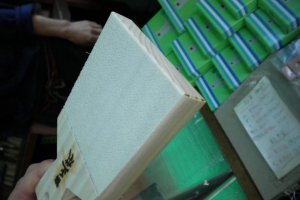Our group clusters around Yukari Sakamoto as we stand on a nearby parking structure peering into Tsukiji's Outer Market during one of her recent tours. Below us it looks like a beehive. Forklifts glide between delivery trucks whisking away the day's catch purchased at auction a few hours before. Ginza-area sushi shop owners bicycle away to begin preparing for lunchtime crowds. Foot traffic in the maze of nearby shops steadily increases as buyers arrive to purchase fresh bonito (a sardine family fish) flakes and powders for making fresh ponzu, dashi, or ramen.
Sakamoto, author of Food, Sake, Tokyo (The Little Bookroom, 2010), and our guide for the morning, leads us through the swarm, sharing her immense knowledge of Japanese food, the ingredients and practices used to prepare it, and the market itself. Trained as a chef and sommelier, Sakamoto's Minnesota friendliness (betrayed by the occasional elongated vowel) gives extra charm and flavor to her tour as she points out an array of sansai (mountain vegetables) just coming into season, various forms of tsukudani (pickled sea vegetables), and, of course, a few of the countless varieties of fish waiting to find their gastronomical homes.
Married to a former buyer at the market, Sakamoto also offers an insider's perspective that our little group eagerly absorbs. We hear news of the market's upcoming move a few kilometers east and that maybe, just maybe, it will take a bit longer than expected. We learn that fish gets cheaper as the day goes on, so buyers try to take advantage of lower prices by swooping in at the last minute. We note that while a famous sushi shop in the market itself is spectacular, there is another with a shorter wait that is just as excellent.
The tour takes us to a third-generation knife shop where the owner greets us with a wide smile as we gaze upon the immense selection of knives, graters and tools for everything from fileting fish to cutting soba noodles to removing fish bones. Particularly eye-catching is a shark skin grater used for wasabi. “It's said to create the best flavor,” said Sakamoto as she holds the small tool in one hand and mimes the recommended circular motion for grating with the other. The owner nods his head in approval as he watches.
More little tidbits, snippets of history, and a few recipes all come spilling out as we wind our way snapping photos, sampling assorted foodly items, and doing quite a bit of shopping. Walking with Sakamoto as she deftly moves from English to Japanese and back again as we pepper her and various shop owners with questions, reveals a world of flavor and story that might otherwise remain a mystery. While we don't visit the hallowed halls of the tuna auction itself - arguably Tsukiji's most famous event despite it's 4am start time - our group feels no sense of disappointment. Strolling about the outer market with a local food guru is an excellent alternative with a reasonable wake-up time.
































